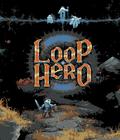In Loop Hero, a mysterious Lich has destroyed everything, and the world is a cold, black, lifeless void — except for a single hero who somehow survived. Now that hero must find a way to defeat Lich and save the world. The only hope is their memories, which can take form, so they can explore a ghostly version of the world as it was before the destruction. Unfortunately, the memories are temporary, and every time the hero leaves, they all vanish. Some things remain, and little by little, the hero can use those things to stabilize the world and empower themselves to defeat the Lich.
The very basic gameplay of Loop Hero has your character at a campfire on a small looping map, and they must follow that loop back to the campfire and fight any enemies along the way. Combat is automated, and your character automatically choose targets and attacks them until one side is dead. Each loop makes the enemies grow stronger. Your eventual goal is to defeat the boss monster that appears after you fulfill specific objectives. As you travel, a day passes, causing new enemies to spawn and certain other events to trigger. You can either choose to clock out at your campfire, which lets you keep 100% of what you've collected; outside of a battle, which lets you keep 60%; or when you die, which lets you keep 30%. It's nice and straightforward, right?
Rather than directly controlling your character, you influence the world. Similar to Hand of Fate, you have a deck of cards that you create before going on a mission. The deck contains various things that can be found in the world, from villages and forests to hidden treasure troves and time-warping crystals. Each one can be placed on the game map to alter how it works. Some spawn monsters, others give you resources, some connect to one another, and others directly oppose. To unlock the boss of an area, you must fill up a large portion of the map up.
For example, take the Rock and Mountain tiles. Each placed tile gives your character an HP bonus. If you place them near one another, they'll give greater bonuses. If you place nine near each other in a 3x3 grid, they'll combine into a big mountain that gives an even bigger HP boost, but it also causes Harpy enemies to spawn. Place more than 10 tiles, and you'll cause a Kobold camp to randomly spawn somewhere on the map. The more you boost your character's HP, the more enemies you have to deal with. On the one hand, fighting enemies is good because you get equipment and resources. On the other hand, fighting too many enemies is bad because you have limited HP and need to have ways to restore it to deal with the enemy swarms.
Equipment can also play into this. Defeating monsters unlocks equipment, with each playable class having its own distinct slots and abilities. For example, the default Warrior can equip armor, ring, shield and sword, each of which can boost either the counter-attack rate, damage, lifesteal, or passive regeneration. On the other hand, the Rogue has two weapon slots, an armor slot, and a shoe slot, but has items that mostly focus on evasion or critical hits. Finding items that synergize allows you to survive much longer than you would otherwise.
I did mention multiple classes, and that is because the game lets you select a class at the start of every run. Each class has a distinct play style, as strange as that may sound for an automated game. The Warrior is about brute force and brute defense and is the beginner default class. The Rogue is squisher but can deal out far more damage, which can be important if you build your loops to capitalize on dealing damage quickly. The Necromancer doesn't attack directly but summons skeletons, and your equipment buffs those skeletons in a variety of ways. It's a nice variety and helps keep the game from feeling too repetitive, even if you're technically doing the same thing over and over.
After every run, you return to your home camp, which begins as a campfire, but as you collect materials, you're gradually able to expand into a small village. You can make farms, libraries, smithies, and various other buildings to grant passive buffs or unlock new features. Each new unlock gives you something new to boost your power in the loop exploration, and eventually, you can unlock absurdly powerful things like the ability to resurrect upon death, which completely changes how you play the game.
Overall, Loop Hero is shaping up to be a fun time-waster. The core gameplay is simple and akin to an idle game, but it is also the kind of game you can have running in a second window and click to from time to time while doing something else. The mechanics seem engaging enough to keep me coming back, and I know there are a lot of combinations I didn't discover in our preview build. Hopefully I'll get the chance to try it out again when it hits in 2021.
More articles about Loop Hero











 Loop Hero is a boundless old school card-based RPG adventure, where instead of playing as the hero, you must craft the world that the hero travels through.
Loop Hero is a boundless old school card-based RPG adventure, where instead of playing as the hero, you must craft the world that the hero travels through.








